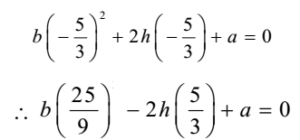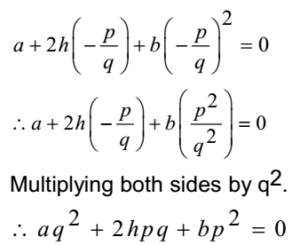Science > Mathematics > Pair of Straight Lines > Condition That Line is Represented by Homogeneous Equation
In this article, we shall study problems to find the condition when one of the lines represented by a homogeneous equation is given.
ALGORITHM :
- Write the auxiliary equation of joint equation.
- Find the slope of given line m.
- Substitute value of m in auxillary equation.
- Simplify and get the condition.
Example – 01:
- If the joint equation of lines is ax2 + 2hxy + by2 = 0. Find the condition that the line 5x + 3y = 0 is one of them.
- Solution:
Given joint equation of lines is ax2 + 2hxy + by2 = 0.
Its auxiliary equation is
bm2 + 2hm + a = 0 ……… (1)
One of the line is 5x + 3y = 0. Its slope is – 5/3
Now – 5/3 must be one of the roots of the auxiliary equation (1),
Substituting m = – 5/3 in equation (1)

Multiplying both sides of the equation by 9
25 b -15 h + 9a = 0
9a + 25 b -15 h = 0
This is the required condition.
Example – 02:
- If the joint equation of lines is ax2 + 2hxy + by2 = 0. Find the condition that the line 3x – y = 0 is one of them.
- Solution:
Given joint equation of lines is ax2 + 2hxy + by2 = 0.
Its auxiliary equation is
bm2 + 2hm + a = 0 ……… (1)
One of the line is 3x – y = 0. Its slope is – 3/-1 = 3
Now 3 must be one of the roots of the auxiliary equation (1),
b(3)2 + 2h(3) + a = 0
∴ 9b + 6h + a = 0
∴ a + 9b + 6h = 0
This is the required condition.
Example – 03:
- If the joint equation of lines is ax2 + 2hxy + by2 = 0. the line 4x – 3y = 0 coincides with one of them. Show that 16 b + 24 h + 9a = 0.
- Solution:
Given joint equation of lines is ax2 + 2hxy + by2 = 0.
Its auxiliary equation is
bm2 + 2hm + a = 0 ……… (1)
One of the line is 4x – 3y = 0. Its slope is – 4/-3 = 4/3
Now 3 must be one of the roots of the auxiliary equation (1),
b(4/3)2 + 2h(4/3) + a = 0
∴ b(16/9) + 2h(4/3) + a = 0
Multiplying both sides of the equation by 9
16b + 24 h + 9a = 0, Proved as required.
Example – 04:
- Find the condition that one of the line represented by ax2 + 2hxy + by2 = 0 is y = mx
- Solution:
Given joint equation of lines is ax2 + 2hxy + by2 = 0.
Its auxiliary equation is
bm2 + 2hm + a = 0 ……… (1)
One of the line is y = mx . Its slope is m
Now m must be one of the roots of the auxiliary equation (1),
b(m)2 + 2h(m) + a = 0
∴ bm2 + 2hm + a = 0
This is the required condition..
Example – 05:
- Find the condition that one of the line represented by ax2 + 2hxy + by2 = 0 is px + qy = 0.
- Solution:
Given joint equation of lines is ax2 + 2hxy + by2 = 0.
Its auxiliary equation is
bm2 + 2hm + a = 0 ……… (1)
One of the line is px + qy = 0. Its slope is – p/q
Now – p/q must be one of the roots of the auxiliary equation (1),

This is the required condition
Example – 06:
- Find the condition that one of the line represented by ax2 2hxy + by2 = 0. is 3x – 2y = 0
- Solution:
Given joint equation of lines is ax2 + 2hxy + by2 = 0.
Its auxiliary equation is
bm2 + 2hm + a = 0 ……… (1)
One of the line is 3x – 2y = 0. Its slope is – 3/-2 = 3/2
Now 3/2 must be one of the roots of the auxiliary equation (1),
b(3/2)2 + 2h(3/2) + a = 0
∴ b(9/4) + 2h(3/2) + a = 0
Multiplying both sides of the equation by 4
9b + 12 h + 4a = 0
This is the required condition
Example – 07:
- Find the condition that the line 4x + 5y = 0 coincides with one of the line represented by ax2 + 2hxy + by2 = 0. OR If the line 4x + 5y = 0 coincides with one of the line epresented by ax2 + 2hxy + by2 = 0, prove that 25a – 40h + 16 b = 0.
- Solution:
Given joint equation of lines is ax2 + 2hxy + by2 = 0.
Its auxiliary equation is
bm2 + 2hm + a = 0 ……… (1)
One of the line is 4x + 5y = 0. Its slope is – 4/5
Now – 4/5 must be one of the roots of the auxiliary equation (1),
b(-4/5)2 + 2h(-4/5) + a = 0
∴ b(16/25) + 2h(-4/5) + a = 0
Multiplying both sides of the equation by 25
16b – 40 h + 25a = 0
25a – 40h + 16 b = 0. Proved as required
Example – 08:
- If the joint equation of lines is ax2 + 2hxy + by2 = 0. Find the condition that the line 3x + 4y = 7 is perpendicular to one of them.
- Solution:
Given joint equation of lines is ax2 + 2hxy + by2 = 0.
Its auxiliary equation is
bm2 + 2hm + a = 0 ……… (1)
Given line is 3x + 4y = 7. Its slope is – 3/4
As one of the lines is perpendicular to given line
Hence slope of one of the line represented by joint equation is 4/3
Now 4/3 must be one of the roots of the auxiliary equation (1),
b(4/3)2 + 2h(4/3) + a = 0
∴ b(16/9) + 2h(4/3) + a = 0
Multiplying both sides of the equation by 9
16b + 24h + 9a = 0
9a + 16b + 24h = 0
This is the required condition
Example – 09:
- If the joint equation of lines is ax2 + 2hxy + by2 = 0. Find the condition that the line x + 2y = 0 is perpendicular to one of them.
- Solution:
Given joint equation of lines is ax2 + 2hxy + by2 = 0.
Its auxiliary equation is
bm2 + 2hm + a = 0 ……… (1)
Given line is x + 2y = 0. Its slope is – 1/2
As one of the lines is perpendicular to given line
Hence slope of one of the line represented by joint equation is 2
Now 2 must be one of the roots of the auxiliary equation (1),
b(2)2 + 2h(2) + a = 0
4b + 4h + a = 0
a + 4b + 4h = 0
This is the required condition
Example – 10:
- If the joint equation of lines is ax2 + 2hxy + by2 = 0. Find the condition that the line 3x + y = 0 is perpendicular to one of them.
- Solution:
Given joint equation of lines is ax2 + 2hxy + by2 = 0.
Its auxiliary equation is
bm2 + 2hm + a = 0 ……… (1)
Given line is 3x + y = 0. Its slope is – 3/1 = -3
As one of the lines is perpendicular to given line
Hence slope of one of the line represented by joint equation is 1/3
Now 1/3 must be one of the roots of the auxiliary equation (1),
b(1/3)2 + 2h(1/3) + a = 0
b(1/9) + 2h(1/3) + a = 0
Multiplying both sides by 9
b + 6h + 9a = 0
9a + b + 6h = 0
This is the required condition
Example – 11:
- If the joint equation of lines is ax2 + 2hxy + by2 = 0. Find the condition that the line px + qy = 0 is perpendicular to one of them.
- Solution:
Given joint equation of lines is ax2 + 2hxy + by2 = 0.
Its auxiliary equation is
bm2 + 2hm + a = 0 ……… (1)
Given line is px + qy = 0. Its slope is – p/q
As one of the lines is perpendicular to given line
Hence slope of one of the line represented by joint equation is q/p
Now q/p must be one of the roots of the auxiliary equation (1),
b(q/p)2 + 2h(q/p) + a = 0
b(q2/p2) + 2h(q/p) + a = 0
Multiplying both sides by p2
bq2 + 2pqh + ap2 = 0
ap2 + bq2 + 2pqh = 0
This is the required condition